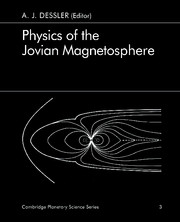Book contents
- Frontmatter
- Contents
- List of tables
- List of contributors
- Foreword
- Preface
- 1 Jupiter's magnetic field and magnetosphere
- 2 Ionosphere
- 3 The low-energy plasma in the Jovian magnetosphere
- 4 Low-energy particle population
- 5 High-energy particles
- 6 Spectrophotometric studies of the Io torus
- 7 Phenomenology of magnetospheric radio emissions
- 8 Plasma waves in the Jovian magnetosphere
- 9 Theories of radio emissions and plasma waves
- 10 Magnetospheric models
- 11 Plasma distribution and flow
- 12 Microscopic plasma processes in the Jovian magnetosphere
- Appendix A Symbols and acronyms
- Appendix B Coordinate systems
- Appendix C Jupiter and Io: selected physical parameters
- References
- Index
6 - Spectrophotometric studies of the Io torus
Published online by Cambridge University Press: 27 October 2009
- Frontmatter
- Contents
- List of tables
- List of contributors
- Foreword
- Preface
- 1 Jupiter's magnetic field and magnetosphere
- 2 Ionosphere
- 3 The low-energy plasma in the Jovian magnetosphere
- 4 Low-energy particle population
- 5 High-energy particles
- 6 Spectrophotometric studies of the Io torus
- 7 Phenomenology of magnetospheric radio emissions
- 8 Plasma waves in the Jovian magnetosphere
- 9 Theories of radio emissions and plasma waves
- 10 Magnetospheric models
- 11 Plasma distribution and flow
- 12 Microscopic plasma processes in the Jovian magnetosphere
- Appendix A Symbols and acronyms
- Appendix B Coordinate systems
- Appendix C Jupiter and Io: selected physical parameters
- References
- Index
Summary
Introduction
A toroidal volume near Io's orbit is made luminous by multiple optical and ultraviolet line emissions excited by resonant scattering of sunlight and by electron collisions. These emitting atoms and ions have been lost from Io. Table 6.1 summarizes the species and detected transitions as of early 1982. In this chapter we focus on spectrophotometric measurements of these emissions and their physical interpretation. The reader is referred to Pilcher and Strobel [1982] for a more general view of torus emission phenomenology.
The concept of circumplanetary atoms of satellite origin was first proposed by McDonough and Brice [1973] for Titan, a satellite with a dense atmosphere from which Jeans escape is probably important. The Io phenomenon was not anticipated owing to Io's low atmospheric pressure [Smith and Smith, 1972; Pearl et al., 1979]; nevertheless, the discovery by R. A. Brown [1974] of sodium optical emission from Io's vicinity established the first example of a satellite that is a rich, continuing source of material for a planetary environment. We know now that the flow of material from Io dominates the particle and energy budgets of the Jovian magnetosphere.
The primary spatial reference here is to a toroidal volume of ~ 4 × 1031 cm3 between about 5 and 7 Rj from Jupiter, which includes Io's orbit but lies near the magnetic equatorial plane or centrifugal symmetry surface. This torus contains the bulk of Io's neutral atom clouds and coincides roughly with the UV source region seen by Voyager.
- Type
- Chapter
- Information
- Physics of the Jovian Magnetosphere , pp. 197 - 225Publisher: Cambridge University PressPrint publication year: 1983
- 45
- Cited by



